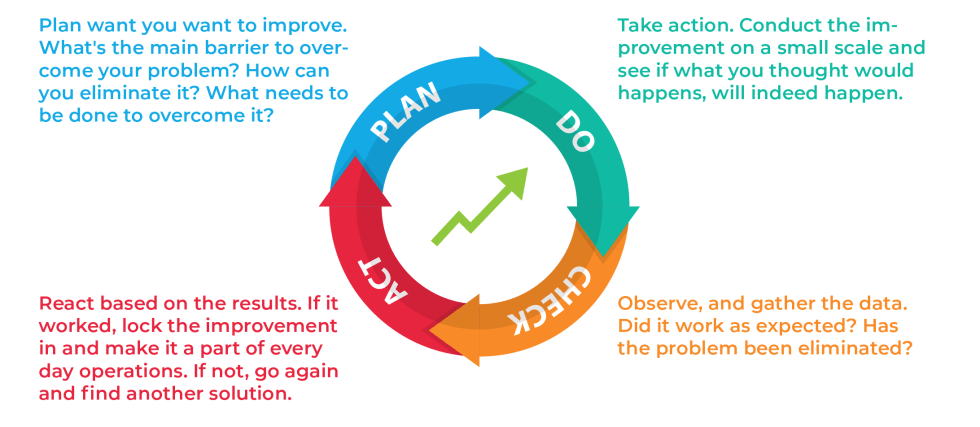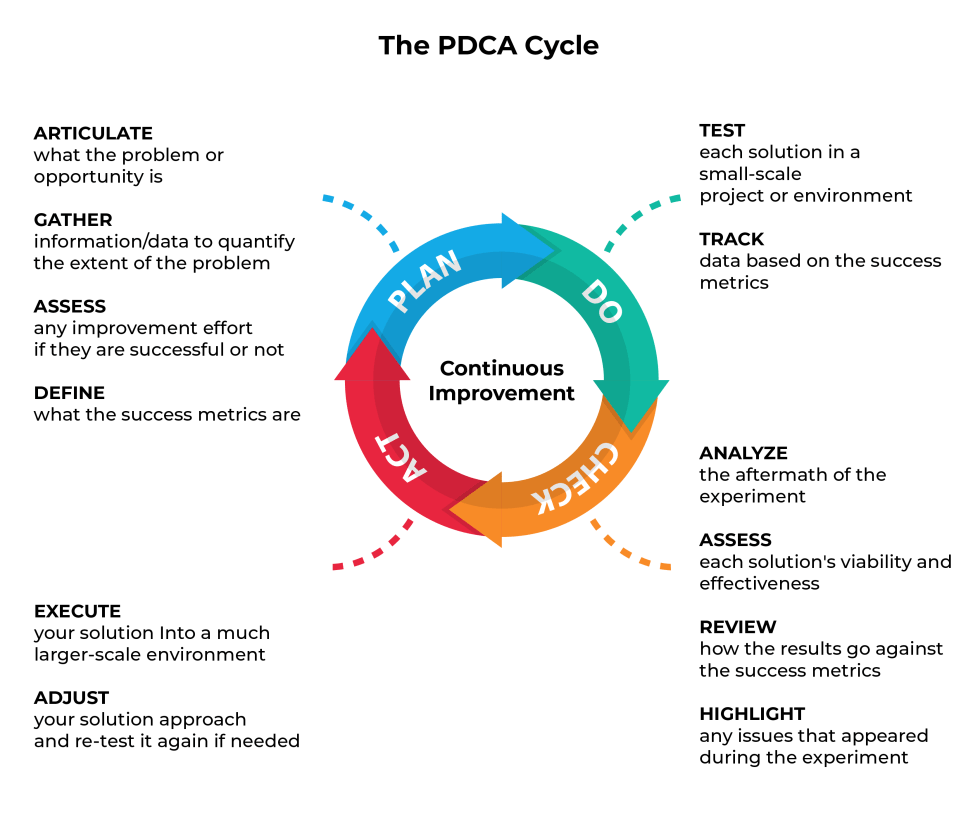Every business aspires to be on the path to continuous improvement and continuous development. However, very few achieve this feat.
The culprit? Poor strategizing.
Setting a clear goal and outlining an actionable roadmap are the basic measures that determine the success rate of such a venture. And these have to be managed with a system of periodic checks and balances.
In this regard, a PDCA model could be the tool for achieving this effect. Let us look at the principle behind the PDCA cycle and its contribution to lean manufacturing.
What is the PDCA Cycle?

PDCA is an acronym for Plan-Do-Check-Act. It is a cycle that employs iterative action to inject continuous improvement in the processes, products, or services. It follows a closed-loop problem-solving approach that considers the feedback as input to introduce a new set of changes. PDCA also goes by the name of Shewhart Cycle, Deming Wheel, Control cycle, or PDSA (Plan-Do-Study-Act) cycle.
The concept was first hypothesized by American physicist Walter A. Shewhart in his book Economic Control of Quality of Manufactured Product. Thereafter, W. Edwards Deming developed the idea further and popularized it by introducing the element of process improvement to make quality control more holistic. Eventually, the methodology intermingled with the Japanese principle of Kaizen, which further refined it to the Plan-Do-Check-Act cycle as we know it today.
Advantages and Limitations of PDCA Cycle
At first glance, the PDCA cycle appears to be a powerhouse of change that sets you on the path to improvement. Needless to say, it introduces a ripple of change throughout your organization in the following ways:
- It lends direction and guides teams to follow the vision of continuous improvement.
- The concept bears a high degree of flexibility allowing it to work with all kinds of projects and applications.
- It is easy to implement and delivers quantifiable results quickly.
- It introduces the standardization of processes by acting as a key component of the SOPs.
- It is a tried, tested, and proven principle to introduce continuous improvement across the organization.
Although the PDCA cycle is a powerful force, it faces its own set of vulnerabilities such as:
- It needs the support of the higher executives for the effectual implementation of the PDCA cycle.
- The value derived from the PDCA cycle is only available by running the cycle over and over again.
- The PDCA cycle calls for long-term commitment during the implementation and learning phases.
- It might not prove to be effective if you are running on a tight schedule as you will have to run the cycle multiple times.
When Should You Use the PDCA Cycle?
In one of the pros of the PDCA cycle, we have mentioned that it bears immense flexibility in versatile settings and applications. On that note, the PDCA cycle finds usage if you wish to:
- Define and streamline a repetitive business process.
- Avoid or eliminate waste, bottlenecks, and inefficiencies.
- Create an SOP while developing a new business process from scratch.
- Expand the features or capabilities of an existing product, process, or service.
- Embrace the continuous improvement ideology.
- Minimize errors and maximize outputs.
- Iterate on changes rapidly to witness immediate results.
- Run tests on multiple solutions quickly and simultaneously.
- Perform small, controlled trials to test the possible outcomes.
Given the above uses and applicability, PDCA can be used in organizations of all shapes and sizes and for different applications, from product management to change management.
Four Stages of the PDCA Cycle

As the name indicates, the PDCA cycle contains four key stages – planning, doing, checking, and taking action. And given that this is a cycle, you will have to restart with planning to commence the next iteration.
Stage 1: Plan
The first stage of the PDCA cycle involves planning. Here, you will be addressing the core issues and mapping out a solution. To facilitate a detailed examination of the case, you will have to ask questions like:
- What is the fundamental problem that you wish to solve?
- Is it the correct and most feasible problem to start working on?
- What would be the data sets and information required to understand the problem and the corresponding root cause?
- What would be the impact of solving this problem?
- What are the resources required to solve the issue and what resources are already present?
- What are some practically viable solutions that you can implement?
- What would be the measure of progress and ultimate success?
- How will you scale the small trials into full-fledged implementation?
- What are the risks and constraints of the project?
Involve all the team members to participate in this introspection. An affinity diagram may help organize thoughts and ideas to filter in the helpful inputs.
While planning may be the starting point, remember that the PDCA is a cycle. As such, even if you don’t have all the answers, wait until the subsequent iterations to discover other elements.
Stage 2: Do
Now is the time to test the proposed solution in a real-world application.
Fortunately, the PDCA cycle does not introduce an overnight change or cause a disruptive overhaul. On the contrary, the “doing” part would be small and incremental until the impact accrues at all stages.
Considering the uncertainty, the best approach for testing your hypothesis involves small-scale implementation, ideally in a controlled environment, so that you can quantify the results and the impact without disrupting the primary chain. As such, pick a team or a particular segment that you wish to target and introduce these changes slowly but continuously. Standardize the plan implementation and ensure that all stakeholders understand their roles and responsibilities.
Stage 3: Check
Checking involves reviewing the tests that you ran in the previous stage and analyzing their results and impact. It helps identify how close you are to achieving your targets, and given this role, it is the most crucial stage as it introduces the continuous improvement component within the PDCA cycle.
This audit stage grants insights into how you can streamline the plan and its execution, eliminate any recurring errors or mistakes, develop a system of checks and balances, and identify the root cause behind any issue. Further, the early detection of potential issues mitigates its impact and intensity before it results in project failure.
After all, you need to know the gap between the current state and the intermediate or desired state to take actions that meld them together. Checking does precisely that by running a system diagnostic of all the action taken so far and the action pending.
Stage 4: Act
So far, you have devised, applied, and tested your plan. If you encounter no major obstacles and enjoy desirable results, then it is time to execute the last stage of the PDCA cycle – Act.
Now is when you see your plan in action as the process or product improvement measures take root throughout your organization. This stage would serve as the standard baseline for the next PDCA iteration.
But before you pull the trigger on this, consider the following factors:
- What are the resources that you need to implement the solution at full scale?
- How will you measure and track the performance of the solution?
- Is there any special training or onboarding required for ensuring implementation and adoption success?
- What is the scope for future developments and improvement?
- What are the key takeaways that can be applied to other projects?
In case the plan experiences hiccups at this stage of implementation, you can revert to the planning stage and start the cycle afresh.
How to Use the PDCA Cycle: An Example

Let us illustrate the use of the PDCA cycle through an example. Suppose you plan to start your own blog but do not know the niche that will garner maximum attention. The PDCA cycle would look like this:
- Plan 1: Creating a timeline, say one year. For the first six months, you will write on five varied topics that you are passionate about.
- Do 1: You write 2 blog posts per week, which amounts to about 10 blogs on the five topics.
- Check 1: You now analyze the performance of the 50 blogs to identify the topics, blog format, and structure of the posts that were highly popular.
- Act 1: In the next six months, you will weed in three popular topics and structures that you will write about in the next six months.
- Plan 2: To write on three different topics that were popular in the previous iteration in the next six months.
By continuing the cycle, you will finally discover the genre that helps your blog grow and settle on it. You can then identify the other specifics of the blog, such as the presence of rich media, the ideal length, the tonality, to align it with your target audience.
Concluding Thoughts
The Plan-Do-Check-Act cycle is the cornerstone of lean management. Its looped mechanism introduces continuous improvement at a small scale until it is amplified to a macro-level. Ensure that you have gone through the Do and Check stages multiple times before you are ready to Act. You will have a polished strategy that puts your project, product, or process on the path to success!






0 Comments